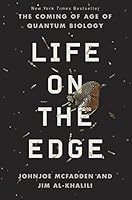
## Metadata
- Author: [[Johnjoe McFadden, Jim Al-Khalili]]
- Full Title: Life on the Edge
- Category: #books
## Highlights
- it has been estimated that over one-third of the gross domestic product of the developed world depends on applications that would simply not exist without our understanding of the mechanics of the quantum world. ([Location 200](https://readwise.io/to_kindle?action=open&asin=B00RKO0KWM&location=200))
- A characteristic of chemical reactions is that they are always reversible. We may write a chemical reaction in the direction: substrates → products. But, in reality, the reverse reaction: product → substrate, is also always proceeding simultaneously. It’s just that, under a given set of conditions, one direction tends to dominate. However, it is always possible to find another set of conditions that favors the reverse chemical direction. For example, when fossil fuels burn in air, the substrates are carbon and oxygen and the sole product is the greenhouse gas carbon dioxide. This is normally considered to be an irreversible reaction; but some forms of carbon capture technology are working toward reversing that process by using a source of energy to drive the reaction backward. For example, Rich Masel from Illinois University has set up a company, Dioxide Materials, which aims to use electricity to convert atmospheric carbon dioxide into vehicle fuel. ([Location 725](https://readwise.io/to_kindle?action=open&asin=B00RKO0KWM&location=725))
- The Nobel Prize–winning physicist Richard Feynman is credited with insisting that “what we can’t make, we don’t understand.” By this definition, we do not understand life because we have not yet managed to make it. We can mix biochemicals, we can heat them, we can irradiate them; we can even, like Mary Shelley’s Frankenstein, use electricity to animate them; but the only way we can make life is by injecting these biochemicals into already living cells, or by eating them, thereby making them part of our own bodies. ([Location 749](https://readwise.io/to_kindle?action=open&asin=B00RKO0KWM&location=749))
- The explosion of scientific knowledge during the Enlightenment of the eighteenth and nineteenth centuries produced Newtonian mechanics, electromagnetism and thermodynamics, and showed that together these three areas of physics successfully described the motion and behavior of all macroscopic everyday objects and phenomena in our world, from cannonballs to clocks, from storms to steam trains, from pendulums to planets. ([Location 758](https://readwise.io/to_kindle?action=open&asin=B00RKO0KWM&location=758))